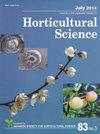Mechanism of Carotenoid Accumulation in Citrus Fruit
Journal of The Japanese Society for Horticultural Science
Pub Date : 2012-07-21
DOI:10.2503/JJSHS1.81.219
引用次数: 83
Abstract
Citrus is a complex source of carotenoids with the largest number of carotenoids found in any fruit. Carotenoid concentration and composition vary greatly among citrus varieties. Satsuma mandarin (Citrus unshiu Marc.) predominantly accumulates β-cryptoxanthin in the juice sacs. Valencia orange (Citrus sinensis Osbeck) predominantly accumulates violaxanthin isomers in the juice sacs. Lisbon lemon (Citrus limon Burm.f.) accumulates low level of carotenoids in the juice sacs. To elucidate the carotenoid accumulation in citrus fruit maturation, the expression of genes related to carotenoid biosynthesis and catabolism was investigated in the three citrus varieties exhibited different carotenoid profile. The results showed that the carotenoid accumulation during citrus fruit maturation is highly regulated by the coordination of the expression for the genes related to carotenoid biosynthesis and catabolism in both flavedo and juice sacs. ‘Tamami’ is a hybrid between ‘Kiyomi’ tangor (Citrus unshiu Marc. × Citrus sinensis Osbeck) and ‘Wilking’ mandarin (Citrus nobilis Lour. × Citrus deliciosa Ten.). To elucidate the mechanism of the accumulation of β-cryptoxanthin in ‘Tamami’, a variety accumulating higher β-cryptoxanthin than Satsuma mandarin, the expression of genes related to carotenoid biosynthesis and catabolism was investigated in the juice sacs of ‘Tamami’. The results showed that the mechanism of β-cryptoxanthin accumulation in ‘Tamami’ was similar to that in Satsuma mandarin. Furthermore, in the recent studies, possible factors, which regulate carotenoid concentration and composition in citrus juice sacs were investigated in vitro.柑橘类胡萝卜素积累的机制
柑橘是类胡萝卜素的复杂来源,是所有水果中类胡萝卜素含量最多的。柑橘品种间类胡萝卜素的浓度和成分差异很大。柑桔(Citrus unshiu Marc.)主要在汁囊中积累β-隐黄质。瓦伦西亚橙(Citrus sinensis Osbeck)主要在汁囊中积累紫黄质异构体。里斯本柠檬(Citrus limon Burm.f.)在汁囊中积累了低水平的类胡萝卜素。为了阐明类胡萝卜素在柑橘果实成熟过程中的积累过程,研究了类胡萝卜素生物合成和分解代谢相关基因在3个类胡萝卜素特征不同的柑橘品种中的表达。结果表明,柑橘果实成熟过程中类胡萝卜素的积累受到黄囊和汁囊中类胡萝卜素生物合成和分解代谢相关基因表达的高度调控。“Tamami”是“Kiyomi”tangor (Citrus unshiu Marc)的杂交品种。柑橘(Citrus sinensis Osbeck)和‘Wilking’柑橘(Citrus nobilis Lour)。×美味柑橘。为了阐明β-隐黄质积累的机制,研究了Tamami汁囊中类胡萝卜素生物合成和分解代谢相关基因的表达。结果表明,“玉ami”中β-隐黄质积累的机制与萨摩柑相似。此外,最近的研究还对柑桔汁囊中类胡萝卜素浓度和成分的调控因素进行了体外研究。
本文章由计算机程序翻译,如有差异,请以英文原文为准。
求助全文
约1分钟内获得全文
求助全文
来源期刊
自引率
0.00%
发文量
0
审稿时长
>36 weeks

 求助内容:
求助内容: 应助结果提醒方式:
应助结果提醒方式:


